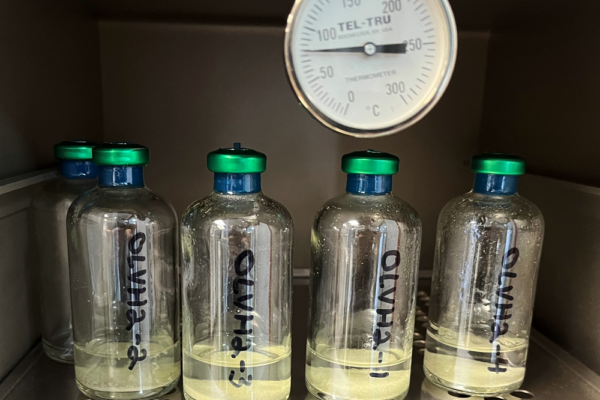Researchers from the University of Texas at Austin are researching methods to produce hydrogen fuel from iron-rich rocks in an emissions-free process.
The university received a $1.7 million grant from the Department of Energy Advanced Research Projects Agency-Energy (ARPA-E). The university is partnering with the University of Wyoming’s School of Energy Resources on the project.
Today, most hydrogen in the U.S. is produced by burning natural gas. This process, sometimes referred to as “blue hydrogen” production, remains a contributor to greenhouse gas emissions alongside traditional fossil fuel use. The industry has also begun to embrace “green hydrogen,” a process that makes use of electricity from solar and wind generation sources.
Now, there may be a new entrant in hydrogen in the form of “geologic hydrogen.”
The research team at UT Austin is exploring the use of different natural catalysts to produce hydrogen gas from iron-rich rocks, mimicking a natural process called “serpentinization.”
In nature, iron-rich rocks release hydrogen as a byproduct of the serpentinization process, a low-temperature rock metamorphosis. It is particularly common at the sea floor at tectonic plate boundaries. Natural catalysts like nickel and platinum group elements are being explored as catalysts to induce this process.
“Natural accumulations of geologic hydrogen are being found all over the world, but in most cases they are small and not economical, although exploration continues,” said Esti Ukar, a research associate professor, UT Austin.
Ukar said the research will test generating larger volumes of hydrogen from iron-rich rocks that would normally take several million years to naturally occur. The research is a first-of-its-kind project to create a process to produce geological hydrogen at an industrial scale.
Researchers at Colorado University Boulder are researching serpentinization in hydrogen production as well. The team is performing accelerated underground testing to better our understanding of the chemical reactions that produce hydrogen naturally.
“If we can accelerate these reactions underground, we can turn rocks into a clean and abundant energy resource,” said Eric Ellison, research scientist at CU Boulder.
A 2022 report from the U.S. Geological Survey (USGS) suggested there may be enough naturally occurring geologic hydrogen to meet global demand for generations, potentially offering a rapid replacement for harmful carbon-emitting fossil fuels.
“Using a conservative range of input values, the model predicts a mean volume of hydrogen that could supply the projected global hydrogen demand for thousands of years,” said USGS researcher Geoffrey Ellis. “We have to be very careful in interpreting this number, though. Based on what we know about the distribution of petroleum and other gases in the subsurface, most of this hydrogen is probably inaccessible.”
Ellis research showed that much of this hydrogen supply is too deeply buried or too far offshore to be economically recovered.
And while USGS said even a fraction of the Earth’s geological hydrogen resources could serve global liquid fuel demand for hundreds of years, relying on fuels that require natural processes that take millions of years may pose its own challenges. Extractive natural fuels are not part of a long-term circular economy, a vision pursued by the National Renewable Energy Laboratory (NREL).

Image: NREL
“Decarbonization of the U.S. economy will require rapid deployment of clean energy technologies,” said NREL. “This will demand large amounts of materials—including scarce, critical materials. Ensuring these materials are available in the necessary quantities and at their highest value and function will necessitate a robust circular economy for energy materials.”
This content is protected by copyright and may not be reused. If you want to cooperate with us and would like to reuse some of our content, please contact: editors@pv-magazine.com.









By submitting this form you agree to pv magazine using your data for the purposes of publishing your comment.
Your personal data will only be disclosed or otherwise transmitted to third parties for the purposes of spam filtering or if this is necessary for technical maintenance of the website. Any other transfer to third parties will not take place unless this is justified on the basis of applicable data protection regulations or if pv magazine is legally obliged to do so.
You may revoke this consent at any time with effect for the future, in which case your personal data will be deleted immediately. Otherwise, your data will be deleted if pv magazine has processed your request or the purpose of data storage is fulfilled.
Further information on data privacy can be found in our Data Protection Policy.